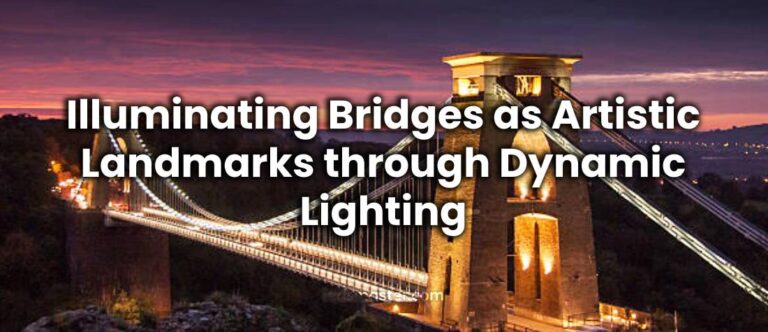
Achieving optimal bridge lighting presents significant challenges, far beyond merely extending the city’s illumination palette. Installation and maintenance of these lights entail navigating complexities such as vibrations and environmental wear, impacting their overall effectiveness. So, what exactly constitutes bridge lighting, its importance, and how do we select the ideal type?
Get your complimentary lighting design today
Bridge lighting transcends mere functional illumination of elevated roadways; it transforms each structure into a distinctive attraction for both locals and visitors alike. The selected lights must meet specific criteria to ensure proper installation and upkeep. Essentially, bridge lighting refers to the strategic placement of diverse light types—varying in color and style—across bridges of all sizes.
Table of Contents
Toggle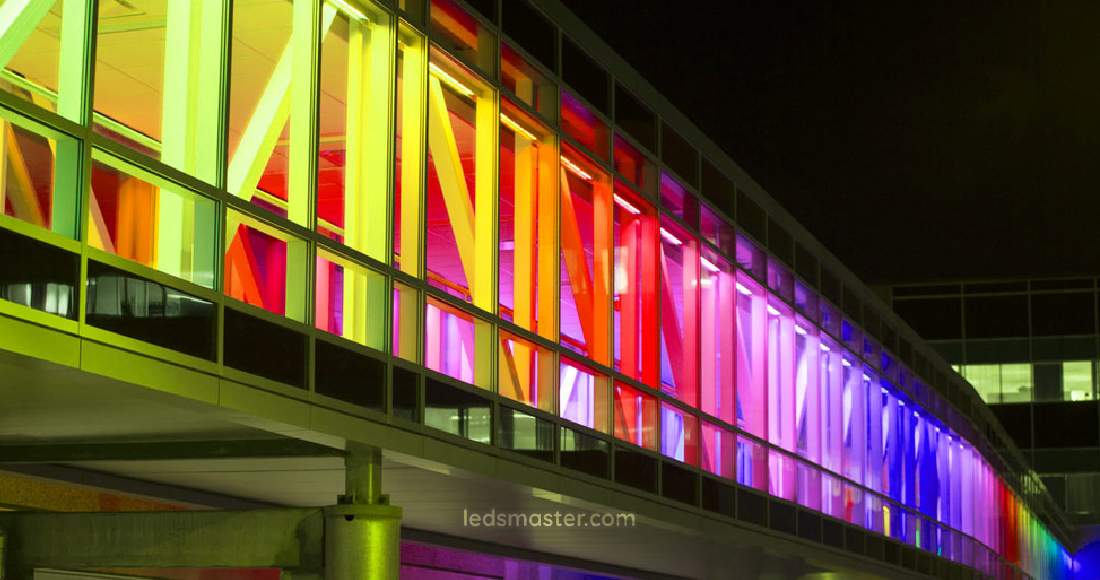
Decorative bridge lights are often characterized by vibrant colors aimed at creating an engaging visual experience, especially appealing to tourists. The most common type of decorative lighting today is LED, widely used on iconic bridges worldwide. These lights are added to give the bridge a distinctive identity or to enhance its aesthetic appeal, transforming it from a mundane structure to a captivating landmark.
During festivities or special occasions, decorative bridge lights can offer innovative effects controlled remotely to add vibrancy to the event.
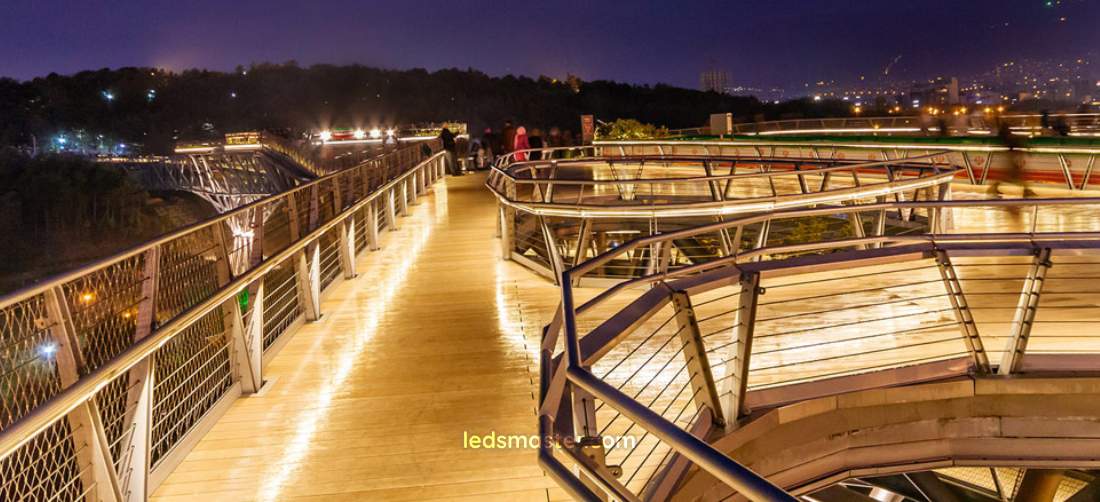
Bridges are used not only during the day but also at night, making adequate lighting essential, particularly for pedestrian safety. The luminance of bridge lighting should be tailored to the needs of users and the surrounding environment. Adapting to ambient light levels helps avoid stark contrasts that can be distracting. Even and diffused illumination is ideal for providing uniform brightness, while high-contrast lighting can highlight specific areas.
Pedestrian bridges often feature handrail lighting using LED bars or fluorescent tubes to aid nighttime navigation.
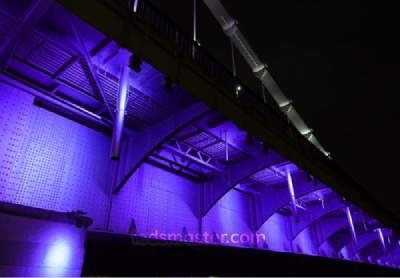 Under-bridge lighting serves both functional and decorative purposes, creating a unique ambiance while enhancing safety for pedestrians and vehicles at night. Available in various colors and shapes, under-bridge lights ensure comprehensive illumination of the entire structure. However, additional lighting types are typically necessary for comprehensive safety and functionality.
Under-bridge lighting serves both functional and decorative purposes, creating a unique ambiance while enhancing safety for pedestrians and vehicles at night. Available in various colors and shapes, under-bridge lights ensure comprehensive illumination of the entire structure. However, additional lighting types are typically necessary for comprehensive safety and functionality.
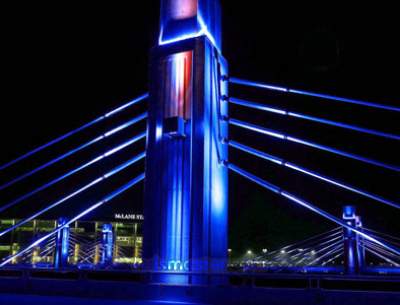 Pillar lights are a modern choice for bridge lighting, designed to provide multiple points of light at varying heights across the structure. Floodlights, integrated into pylons or tall masts, are effective for illuminating darker or challenging areas of the bridge, including suspension bridges. Their versatility ensures thorough and efficient lighting coverage.
Pillar lights are a modern choice for bridge lighting, designed to provide multiple points of light at varying heights across the structure. Floodlights, integrated into pylons or tall masts, are effective for illuminating darker or challenging areas of the bridge, including suspension bridges. Their versatility ensures thorough and efficient lighting coverage.
Bridge lighting serves multiple crucial purposes beyond mere aesthetics. Here are key reasons why proper bridge lighting is essential today:
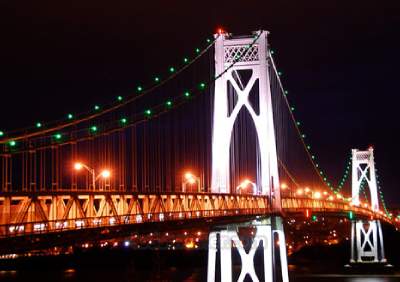 Well-designed bridge lighting enhances the visual appeal of bridges, transforming them into iconic landmarks that attract tourists and delight locals alike. The variety of lighting options—from different styles to colors—creates unique and captivating nighttime spectacles. Bridges often serve as focal points within communities, contributing to the overall beauty of their surroundings, especially in areas connected by rivers, canals, or lakes.
Well-designed bridge lighting enhances the visual appeal of bridges, transforming them into iconic landmarks that attract tourists and delight locals alike. The variety of lighting options—from different styles to colors—creates unique and captivating nighttime spectacles. Bridges often serve as focal points within communities, contributing to the overall beauty of their surroundings, especially in areas connected by rivers, canals, or lakes.
Effective bridge lighting significantly improves safety for pedestrians and motorists alike. Illuminated pathways ensure pedestrians can navigate safely, while well-lit roads minimize the risk of accidents for drivers crossing the bridge. Adequate lighting also deters vandalism, helping to preserve the structure and maintain its functionality over time. Conversely, inadequate lighting has been linked to serious accidents and safety concerns.
Bridges often symbolize the identity of a city or region, making them focal points for celebrations and events. Local authorities frequently utilize bridge lighting to create stunning visual effects during festivals like New Year’s Eve celebrations or local cultural events. Such displays not only enhance the city’s reputation but also attract tourists, boosting local tourism and economic activity.
By prioritizing proper bridge lighting, communities can not only enhance their aesthetic appeal but also improve safety, promote cultural events, and attract visitors, thereby enriching the overall quality of urban life.
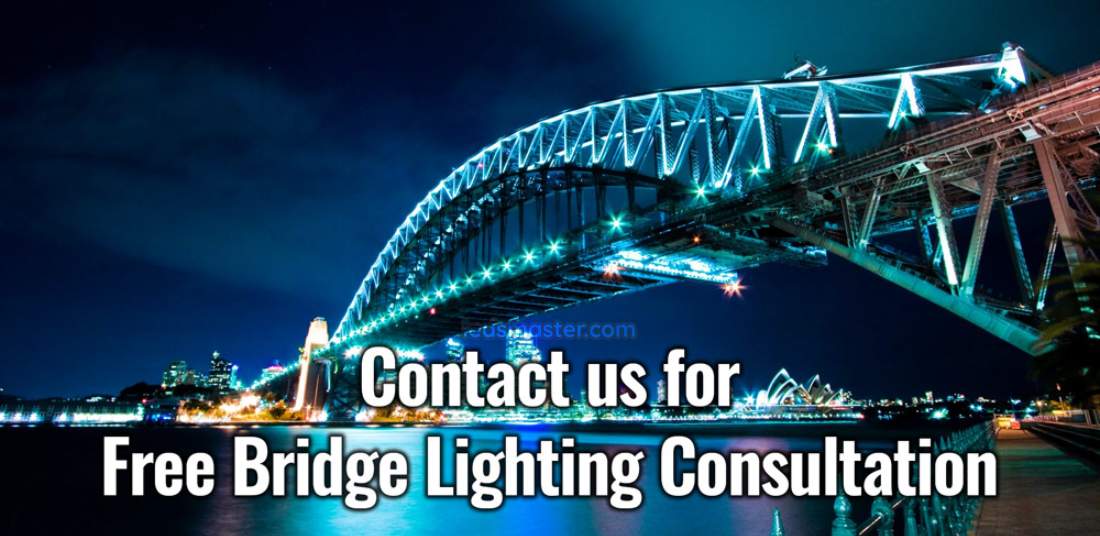
To select optimal bridge lighting, several key factors must be considered. These considerations ensure satisfactory outcomes and mitigate concerns regarding potential future damage. Here are the critical factors to evaluate when choosing the ideal lights for illuminating bridges in our town or city.
Among the top-rated lighting materials available today, we encounter metal halide, HPS, and the modern LED solutions. Both metal halide and HPS lights are traditional yet effective choices for illuminating bridges, each with distinct characteristics. HPS lamps emit an orange light, while metal halide bulbs typically provide a white light.
Metal halide lights are valued for their high-intensity output, whereas HPS lamps are often preferred for street and bridge lighting due to their warmer, more appealing color. However, contemporary bridge constructions increasingly favor high-quality LED lights for several compelling reasons. LEDs combine strong brightness with low energy consumption and minimal decay over time.
LED lighting also offers the advantage of controllable color temperatures, enhancing both the aesthetic appeal of the bridge and visibility across its surface. Color-changing LED lights are also a popular option, providing versatility in bridge illumination solutions.
Bridges worldwide exhibit a variety of colors, influenced by their surroundings, desired aesthetic outcomes, and the type of lighting used. HPS bulbs typically emit a warm white to yellowish glow, whereas LEDs offer options ranging from warm to cool hues, including colored lighting.
In most cases, warmer colors are preferred for bridges, enhancing their vibrancy and appeal to passing vehicles and pedestrians alike.
Understanding the optimal beam angle of a light is crucial when making a well-informed decision. Essentially, the beam angle determines the area a lamp can effectively illuminate at a given distance, which is particularly significant for floodlights and spotlights used on bridges.
Spotlights typically emit a narrow beam, reaching up to 45 degrees, while floodlights have a wider beam spread, reaching up to 120 degrees. This broader spread allows floodlights to illuminate a larger area with the same lumen output as a spotlight. Hence, floodlights are preferred for larger bridges where achieving a brighter overall illumination is desired.
Durability primarily hinges on the lifespan of a light. Different types of lights boast varying lifespans. LED lights, renowned for their longevity, offer exceptionally durable lighting solutions. Similarly, HPS lights also feature a robust lifespan due to their quality construction.
Price always plays a crucial role in our purchasing decisions, especially when considering bridge lights, which can be quite costly. However, the wide range of options available on the market means you can find suitable bridge lights to fit your budget. While price often correlates with quality, there are many affordable yet reliable choices available today.
LED lamps, known for their advanced features, generally come at a slightly higher cost. However, when purchasing in bulk or for larger installations, you can still find cost-effective options among LED lights.
Bridges, being outdoor structures, are exposed to various weather conditions and environmental elements. When installing lights on bridges, especially considering strong rains, winds, and other harsh conditions, it’s crucial that these lights are specifically designed to withstand such challenges. This ensures safety for everyone crossing the bridge during inclement weather.
Therefore, when selecting outdoor lamps for bridges, it is essential to ensure that their main fixtures are waterproof and resistant to environmental factors.
Color-changing lights are a captivating visual feature wherever they are used, especially on magnificent bridges where they enhance the aesthetic appeal. Installing these lamps on various parts of a bridge is straightforward. Simply replace existing lamps or add specially designed ones that allow remote color control via an App. This intuitive interface lets you adjust colors, intensity, and stability of the lights. Typically, bridge lights are connected to a central laptop within the local community’s offices.
The total cost of installing bridge lights varies based on factors such as bridge surface area, type of lights chosen, installation complexity, and labor hours required. Costs can range from thousands to millions of dollars. For instance, lighting the Bay Bridge in San Francisco with 25,000 lights required a budget of approximately $8 million. Funding for such projects often comes from individual donations or various forms of financing.
Impressive bridge lighting serves as a tourist attraction, particularly for less-visited areas, contributing to local economic growth. For example, the installation of 25,000 lights on the Bay Bridge is expected to generate approximately $97 million for the local city’s economy.
Many bridge lights installed years ago, using metal halides or fluorescents, are less energy-efficient compared to modern LED lights. However, ongoing projects aim to replace old lights with energy-efficient LED lamps, reducing energy consumption by up to 50%.
The time required for installing bridge lights varies based on factors such as bridge size, number of lights, workforce, and environmental conditions. For a large bridge, the installation process is usually phased and may take up to a year to complete. Smaller bridges or projects involving light replacement while retaining existing fixtures can be completed in considerably less time.
Around the world, several bridges have undergone significant efforts to provide them with a unique lighting design that attracts thousands of tourists each year. Here’s a glimpse at four of the most impressive bridges:
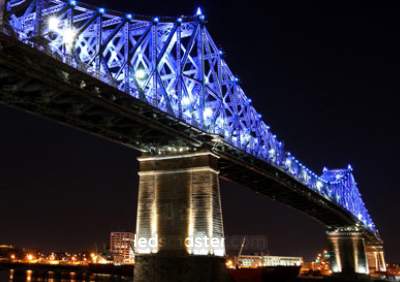 The Jacques Cartier Bridge in Montreal is celebrated for its role in connecting the island of Montreal to the broader world and for its mesmerizing light display. As the sun sets each evening, the bridge is bathed in hues that mirror the colors of the sky, with a unique shade selected daily from a palette of 365 colors. At midnight, a special show cycles through all colors to determine the next day’s illumination, ensuring a constantly evolving visual spectacle.
The Jacques Cartier Bridge in Montreal is celebrated for its role in connecting the island of Montreal to the broader world and for its mesmerizing light display. As the sun sets each evening, the bridge is bathed in hues that mirror the colors of the sky, with a unique shade selected daily from a palette of 365 colors. At midnight, a special show cycles through all colors to determine the next day’s illumination, ensuring a constantly evolving visual spectacle.
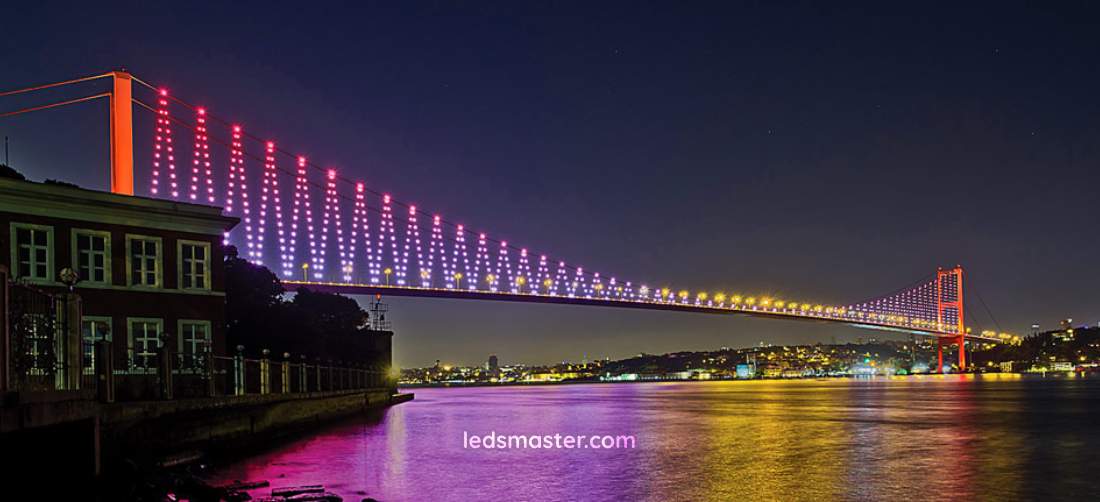
Spanning continents and accommodating more than 200,000 vehicles daily, the 15 July Martyrs Bridge stands as a symbol of Istanbul’s unity and grandeur. Recently enhanced with advanced LED technology, the bridge now boasts a contemporary and visually stunning appearance. Digitally controlled lights adorn the bridge’s steel cables, towers, and rails, offering a dynamic array of colors and captivating visual displays that enchant both locals and visitors alike.
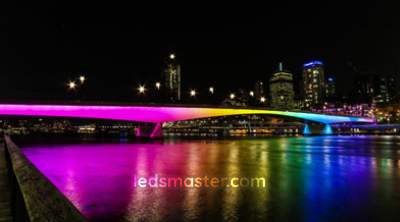 Brisbane, renowned for its vibrant culture and urban energy, enhances its iconic Victoria Bridge with cutting-edge LED lighting. Positioned strategically beneath the footpath, these lights can be programmed remotely to create intricate visual effects and captivating color combinations. This modern lighting design preserves the bridge’s distinct identity while adding a touch of spectacle to Brisbane’s riverscape.
Brisbane, renowned for its vibrant culture and urban energy, enhances its iconic Victoria Bridge with cutting-edge LED lighting. Positioned strategically beneath the footpath, these lights can be programmed remotely to create intricate visual effects and captivating color combinations. This modern lighting design preserves the bridge’s distinct identity while adding a touch of spectacle to Brisbane’s riverscape.
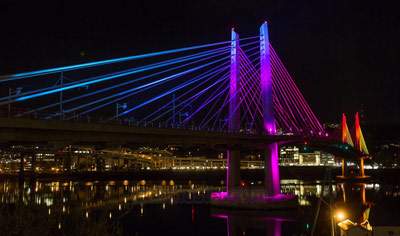 Spanning the Willamette River, the Tilikum Crossing Bridge in Portland is a testament to modern engineering and artistic innovation. Adorned with vibrant lights conceived by digital artists and programmers, the bridge’s illumination is more than mere decoration—it is a responsive display that adjusts its colors and patterns based on environmental cues such as the river’s speed, temperature, and height. This dynamic interplay of light and nature creates a truly immersive experience for pedestrians and cyclists crossing this iconic Portland landmark.
Spanning the Willamette River, the Tilikum Crossing Bridge in Portland is a testament to modern engineering and artistic innovation. Adorned with vibrant lights conceived by digital artists and programmers, the bridge’s illumination is more than mere decoration—it is a responsive display that adjusts its colors and patterns based on environmental cues such as the river’s speed, temperature, and height. This dynamic interplay of light and nature creates a truly immersive experience for pedestrians and cyclists crossing this iconic Portland landmark.
Bridge lighting serves not only an aesthetic purpose but also enhances the vibrancy and appeal of a city. These impressive light displays contribute to the cultural identity and tourist attraction of each location. With advancements in technology, bridge lighting has become more energy-efficient and durable, benefiting both local communities and tourism. Cities worldwide should consider illuminating their bridges to transform them into secure and iconic landmarks of their respective places.
From decorative LED lights that transform bridges into iconic landmarks to functional lighting ensuring pedestrian and vehicular safety at night, the choices in bridge lighting are diverse and essential. Beyond mere illumination, these lights contribute to community identity, cultural celebrations, and economic growth through tourism. By embracing modern technologies like LED for their efficiency and versatility, cities can not only beautify their landscapes but also ensure sustainable and vibrant urban environments for years to come.